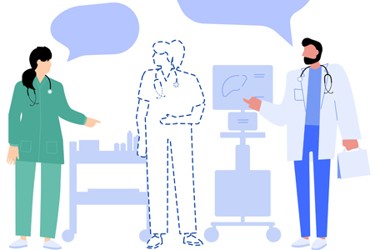The Secret(s) To Solving The Clinical Trials Staffing Crisis
By Kathi Enderes, SVP, research, and global industry analyst, The Josh Bersin Company

The healthcare industry is the largest employer in the U.S.; one in seven Americans work within it. Yet, new research from The Global Workforce Intelligence (GWI) Project has unveiled a crisis currently in motion that will continue to develop in the coming years. By 2025, there will be a staggering demand-supply gap of 2.1 million healthcare workers — or one in three roles remaining unfilled.
This major piece of research, based on Eightfold Talent intelligence and interviews with chief human resources officers of major U.S. healthcare companies and combined with other data sources including The Josh Bersin Company’s own insights, reflects workforce practices in use today across tens of thousands of companies globally. Our rigorous work gave us clear findings: healthcare and clinical trials management urgently needs to focus on organizational redesign, right now, to fill the growing gap.
Current approaches are not working and the leading, most adaptable companies — we call them “trailblazers” — are already acting to avoid disaster. We found that high-performing healthcare organizations already have four to five times more organizational redesign and technology roles than their less-advanced counterparts.
Here, I will expand on this idea, exploring how automation, human augmentation, and the re-engineering of clinical delivery are among the solutions needed within this redesign.
The People Challenge — Where Is The Gap Coming From?
When many theorize about the challenges on the horizon in healthcare, they often gravitate toward a technology challenge, first and foremost. The belief is that the industry needs to find ways to upskill the vast numbers of existing workers to become proficient with the rapidly accelerating technology solutions.
However, our research revealed the opposite. The challenge actually centers around using technology to tackle the people challenge — attracting the vast amount of people needed to frontline roles.
In September 2022, there were 6.6 million clinical research jobs posted in the U.S., according to CareerBuilder, yet only 5.7 million available hires. Additionally, for every clinical research coordinator (CRC) looking for a job, there are seven jobs posted.
Many clinical trials employees are in the later stages of their career, and many left the profession altogether after the pandemic. Combine this reality with the woefully little thought put into employee experience, and the result is a very high turnover of people. Organizations can’t hire their way out of this problem for many reasons, including the fact that standard approaches to recruitment simply cannot cope as that turnover becomes greater and greater.
“The projected growth of the clinical research industry is demanding a diverse, research-ready workforce that doesn’t exist today,” says Susan Landis, executive director of ACRP, the Association of Clinical Research Professionals. “Right now, the clinical trial workforce is not keeping up with the workload, ultimately threatening to delay delivery of innovative treatments to patients who need them.”
How Do We Plug The Gap?
Our research showed that up to 48% of the work required to successfully close gaps in clinical capability today could be achieved through the redesign of work, jobs, and employment models, as well as retaining existing workers through an improved employee experience.
There are three main elements to this new, innovative talent model:
1. Benchmarking current workforce skills and identifying roles in decline.
This involves using artificial intelligence (AI) to identify trends in skills, roles, and career pathways by identifying skills adjacencies and projecting staffing issues and overflows. This strategic approach to planning is critical to determine specific gaps on the horizon and to identify which people and workforce strategies the organization should focus on.
2. Reskilling. Nonlinear career pathways are a proven but lesser-known solution.
In short, this is the process of helping people outside of the healthcare industry pivot from lower income, lower skilled roles into more satisfying healthcare and clinical research jobs. For example, employers could invest in non-clinical workers, such as receptionists, to study for the relevant certifications before eventually moving them into new roles in the healthcare space. Organizations like Bon Secours Mercy, Providence, and New York-Presbyterian are all currently doing this well, linking into their strategic workforce planning capabilities and even revisiting the need for degrees and certifications.
If organizations can support workers effectively along nonlinear career pathways, with education and practice, we found this could help create around 500,000 care providers in healthcare.
In the clinical research arena, it is possible to start with some easy wins here. ACRP, in its white paper “Barriers to Bridges: Addressing the Urgent Need for a Diverse, Research-Ready Workforce Within the Clinical Research Profession” calls for industry leaders to address two initial key barriers — a lack of awareness about clinical research as a profession and the unproven stipulation for two years of experience. Tackling both areas would help in a huge way to enable nonlinear career pathways to flourish.
3. Redesigning roles and work. The redesign of work, across multiple fronts, must happen — and existing employees must be taken on the journey.
For example, if a small proportion of a clinical research role is focused on specialized work, with a large proportion spent doing administrative work, then why not redesign roles that can take on the rest of the work, leaving specialists with more time to spend on their specialty? You also can add technology to the mix to automate work activities that are done better, faster, and cheaper by a machine.
Or, in a real-world example, Mercy Health has redesigned nurses’ full-time roles to meet demands for flexibility, allowing them to pick their hours based on the money they need, their availability, and their stress levels. Mercy Health’s model is very similar to one well-known for Uber drivers. They found that, contrary to their expectations around scheduling chaos, this went exceptionally smoothly and made a colossal improvement in their ongoing issues with employee retention. We have an entire case study for our research members on this innovative practice.1,2
Overcoming The Financial Obstacles
As we all know, asking businesses to prioritize long-term solutions over short-term gains is often a huge obstacle. However, there are immediate benefits that employers in the clinical space can reap by addressing these factors right now. In the U.S., every employer can get a tax credit up to $5,250 a year for every employee to offset educational expenses, like retraining into healthcare.
And supporting employees, across all fronts, is another huge factor here, as they may be wary of embarking on a career pivot due to cost or time concerns. Mentors can support employees as they balance their commitments to study, work, and domestic obligations, and organizations must pay up front to cover the cost of courses for their workers. Many currently reimburse workers after taking a course, but this a major barrier to low-income workers that such a career pivot targets.
What Are You Waiting For?
Reskilling and the redesign of work, jobs, and employment models are both key to maintaining optimal operations within healthcare and clinical trials settings — and tackling the staffing crisis that is a reality today and only bound to get worse over the next few years.
Healthcare is very much leading the way in terms of technology and innovation, despite opinions to the contrary, and the potential is very much there to implement innovative ideas like this. Our research shows how it can be done. The impact of staffing issues on product development and patient care is already being felt. The time to take a fresh view of human resourcing is now.
References:
- How Mercy grew by over 1,000 internal gig nurses & cut travel agency spend by 50% in 2022 while improving the nurse experience. Published 23 January 2023. https://go.beckershospitalreview.com/pi/mercy-trusted-health-webinar
- Healthcare at a Crossroads: Filling the Urgent Talent Gap in Clinical Care. The Josh Bersin Company. https://joshbersin.com/gwi-project-research-healthcare-industry/
About The Author:
 Kathi Enderes is the SVP, research, and global industry analyst at The Josh Bersin Company. Obsessed with making work better, Kathi has over 20 years global experience in human capital, talent and performance management, and change management from consulting with IBM, PwC, EY and Deloitte. She also currently serves on the board of the People Intelligence Alliance, a community of people analytics leaders aimed at transparency, ethics, and successful use of people-related insights.
Kathi Enderes is the SVP, research, and global industry analyst at The Josh Bersin Company. Obsessed with making work better, Kathi has over 20 years global experience in human capital, talent and performance management, and change management from consulting with IBM, PwC, EY and Deloitte. She also currently serves on the board of the People Intelligence Alliance, a community of people analytics leaders aimed at transparency, ethics, and successful use of people-related insights.
